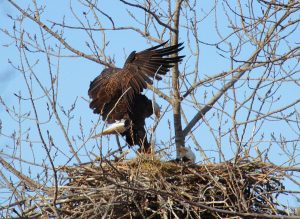The Niagara River is unique natural resource. It is naturally divided by the Niagara Falls consisting of three separate waterfalls which combine to form the highest volume waterfall in North America (168,000 m3 / minute or 2,800 m3 / second). The Niagara River corridor supports over 1250 species, including:
- 338 species of birds
- 35 species of mammals
- 14 species of reptiles
- 17 species of amphibians
- 12 species of mussels
- 734 species of plants
- Of these species 59 are protected federally in Canada and 70 provincially in Ontario.
- 1 species is protected federally in the U.S. and 54 species protected by New York State.
The Niagara River corridor supports numerous species during critical life stages (e.g., nesting, migration, spawning, overwintering).
There are over 60 fish species found in the Niagara River, including Lake Sturgeon, Smallmouth Bass, Yellow Perch, and Rock Bass…just to name a few! Periodic large migratory runs of fish species such as Emerald Shiner, Spottail Shiner and Gizzard Shad are common in the Upper Niagara tributaries. The Emerald Shiner (Notropis atherinoides) is a keystone species in the Niagara River and are considered the base of the food web for many fish-eating birds and predatory fish. They are a very important food source for the Common Tern (Sterna hirundo), which is a threatened species in New York State.
The Niagara River Corridor is a critical overwintering site for waterbirds as it stays unfrozen throughout the cold winter months when most other freshwater bodies are frozen. During this period of extreme hardship, 92 species of birds overwinter in the site, including large congregations of at least 40 species of waterbirds (including gulls and waterfowl).

The Niagara River corridor forms part of the Atlantic Flyway, one of four major bird migration corridors in North America.
The Niagara River corridor also includes two ecological communities considered vulnerable, Calcareous Cliff Community and Calcareous Talus Slope Woodland, as well as rare old growth forests.
At least six waterbirds congregate in the Niagara River Corridor in globally significant numbers based on single day surveys, including:
- Canvasback (Aythya valisineria): 6,000 to 14,000
- Greater Scaup (Aythya marila): 15,000
- Red-breasted Merganser (Mergus serrator): 9,000
- Bonaparte’s Gull (Chroicocephalus philadelphia): 4,000 to 100,000
- Herring Gull (Larus argentatus): 40,000 to 50,000
- Ring-billed Gull (Larus delawarensis): 27,000 to 32,000
The Northern Dusky Salamander (Desmognathus fuscus) – Carolinian Population
Salamanders are representative of pristine habitat conditions, as they cannot tolerate any type of pollution. In Ontario, the Northern Dusky Salamander’s entire range consists of a single, cascading stream in the Niagara Gorge on the Canadian side of the river, occupying no more than about 5 m. Surveys have identified some 22 individuals and indicate a total adult population that is probably fewer than 250 individuals. Its minute range makes this salamander highly susceptible to extirpation (elimination from the area) if any change to its habitat were to take place. Major threats to this salamander are activities that could affect the water table and dry out the spring that supports its habitat. This species is listed as Endangered in Ontario and is protected under the Endangered Species Act, 2007.

